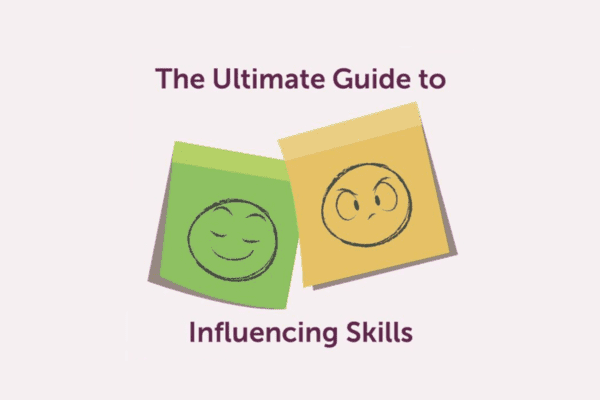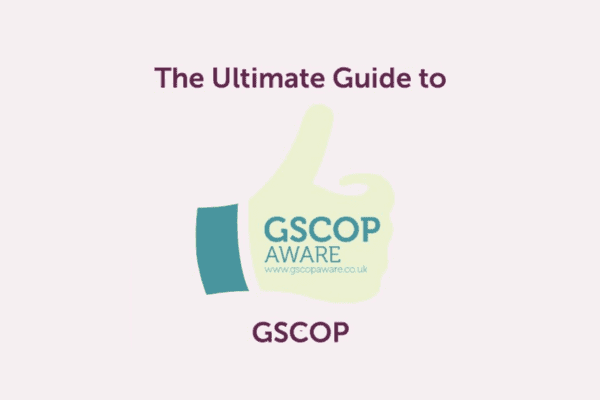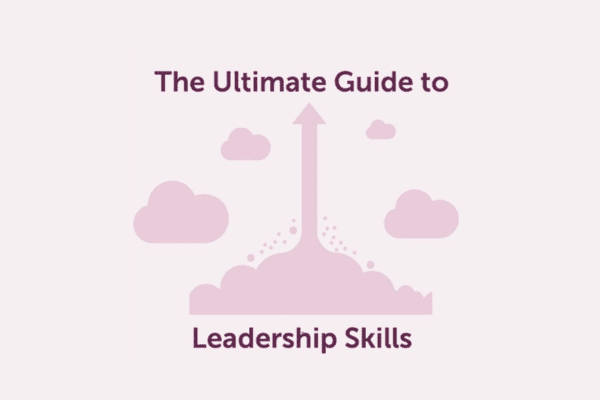Which Personality Type Are You?
First off, the Myers Briggs type indicator is about preference, not ability.
Try this: Fold your arms – What does that feel like? Normal? Natural? Comfortable?
Now fold them the other way around – You might have thought it was going to be difficult. Perhaps even you wouldn’t be able to do it at all. Did you manage it even so?
Okay, now unfold them again – What did folding them in a different way feel like? Uncomfortable? Unnatural? Weird?
Okay. Fold your arms again. Did you revert to your most comfortable version?
If so, it’s not surprising. We usually do this without thinking. There’s a similar principle behind the preferences identified by the Myers Briggs Type Indicator. All in all, it’s about you doing what you do naturally. Briggs Myers helps you know why.
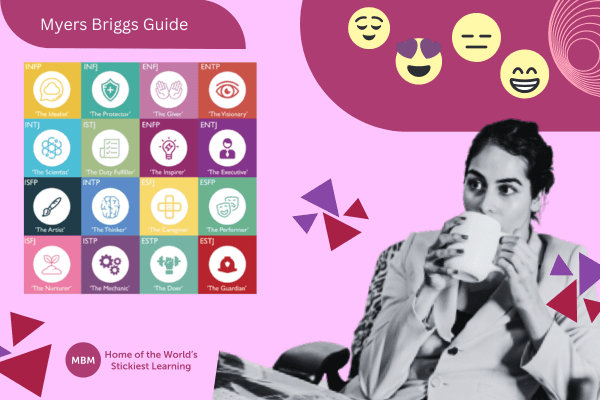
This Ultimate Guide Will Explore:
- What is a Myers-Briggs Type Indicator (MBTI)? (Above)
- Where Did Myers Briggs Begin?
- So…What can MBTI Do for Me?
- What Does the MBTI Look at?
- How Can I Guess People’s Myers Briggs Types?
- Do We Know the MBTI of Anyone Famous?
- Further Reading and Resources
Now, Back to Our Conversation… Ability
We can fold our arms differently – we have the ‘ability’. This doesn’t necessarily mean that we want to fold our arms the new way going forward. And why would we, if we can do it more easily and more comfortably in our preferred way? So, if we can work in ways we are naturally ‘wired’, using our innate gifts, then we are more likely to feel at and perform at our best.
It’s worth saying that knowing your personality type doesn’t suddenly make you aware of what you enjoy most or least. No doubt, you already know this. However, what it does do is shine a light on why this might be. Of course, we may still have to get on and do those things we relish least in the world of work and in life. We may even get quite good at doing them! However, our preferences won’t change because of our newfound understanding.
Introverts & Extroverts
“For many Extroverts, “hell at a party” is “not being able to get in.” Contrarily, many introverts see it as “being there.”
An Extrovert may have to take more time inside their head than they would ideally like in order to complete that report. On the contrary, an Introvert may need to take more time being ‘out there’ networking with people than they might naturally choose. They can do it, but it might feel uncomfortable, perhaps even draining, if done for long periods of time.
We’ve mentioned Extroverts and Introverts. But of course, the psychological type indicator is much more than these descriptions alone. They are just two of the eight preferences that this particular personality indicator measures, and are perhaps what people think of first when it comes to this personality instrument. Later in this article, we’ll look at some speedy ways to make informed guesses about other people’s personality type indicator preferences. Are you ready?
1) What is a Myers Briggs Type Indicator (MBTI)?
In the world of personality assessments, this Personality Type Indicator is a questionnaire to be completed by you. The results of the questionnaire show psychological preferences about how you make decisions, and how you perceive the world. The outcome of the test is based on 4 metrics;
- Introversion or Extraversion,
- Sensing or Intuition,
- Thinking or Feeling,
- and Judging or Perceiving.
Then, one letter is taken from each of the 4 metrics/categories to produce a four-letter test result, such as ‘ISFJ’ – Mother Theresa, or ‘ENTP’ – Donald Trump, or ‘INTP’ – Albert Einstein.
For example, Mother Theresa was Introverted, more than Extroverted. She was more Sensing than Intuitive, more Feeling than Thinking and finally, and more Judging than Perceiving. Hence, ISFJ.
Click the image below for a higher resolution of all the personality types.
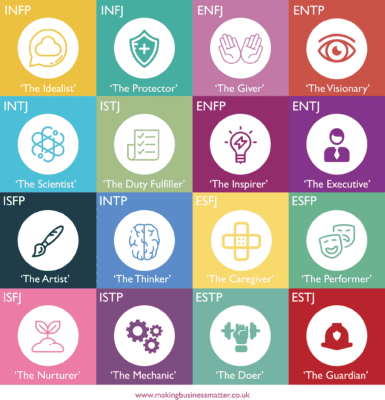
What is Your Myers Briggs Personality Type?
Under the MBTI umbrella, there are 16 personality types, as seen below. You can click on any for an in-depth and informative article about each personality type; its strengths, weaknesses and compatibility with other personality types.
Alternatively, head over to our MBTI articles page, for an overview of all the personalities in one place.
Now have a go at identifying your Myers Briggs Type Indicator by filling out the quick cheat sheet below. Click on the image for a higher resolution:
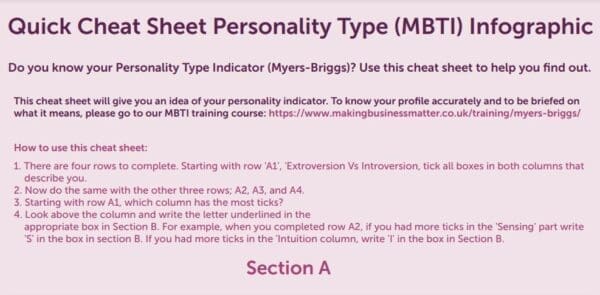
Knowing your MBTI is an explanation, not an excuse. It helps explain why you do what you do. It doesn’t, therefore, justify pleas of ‘I can’t possibly sit and finish this report by myself. Do you not realise that I am an Extrovert?!’
Instead, the psychological tool gives us information about why Extroverts might feel the way they do about such things. But more about Extroverts (and Introverts) later. Many people live long and happy lives without ever knowing their personality type indicator… Yet I think it’s a richer experience when they do!
Now let’s delve a bit more on the history side of things.
2) Where Did Myers Briggs Begin?
Briggs’ MBTI is based on a theory of personality type initiated by Swiss psychiatrist Carl Jung. During the years of World War II, the mother and daughter team, Katharine Cook Briggs and Isabel Briggs Myers took Jung’s work further. They were curious about how people were similar, and how they were different. They wanted to do their part by finding a way for people to understand rather than destroy each other. Also, more immediately, they saw many people in the war years taking jobs out of patriotism, but finding themselves really unhappy when they were being prevented from using their gifts in the roles they had taken.
From very humble beginnings, taking over 20 years to build on the work that Jung had started, they went on to create the MBTI questionnaire that we know and use today. It has been translated into over 20 languages and is used to help people in numerous organisations and institutions with leadership, influencing, change, career development, team-work, conflict, managing others, developing relationships and more besides. All in all, there are 16 different MBTI Types, none better or worse than any other.
3) So…What Can MBTI do for Me?
Finding out about your type frees you to recognise your own natural preferences and to trust your potential for growth and excellence. It can be a real eye-opener when thinking about ‘what next?’ in your career. Or even when thinking about how to bring more joy to your current role – how might you make it more ‘you shaped’?
Even more, it can help you make sense of feedback you might receive or how you can build better relationships at home, with colleagues and customers. The list is endless, as its value for self-awareness and self-management is enormous. I hear people calling MBTI a ‘personality test’ or ‘personality quiz’. But it’s neither of these.
There are no right or wrong answers with the Personality Type Indicator, though some people wrongly call it either a ‘test’ or a ‘quiz’. Instead, each of the 16 types has a unique set of gifts and blind spots. Knowledge of the type helps us appreciate the different gifts that people bring. So often if people are ‘different’ to us, we see only their downsides; we don’t always value what they naturally have to offer and that they bring us balance.
Think About Your Own Team For a Moment
Imagine how good it would be to release people, wherever possible, to work in ways that are natural and comfortable for them. Picture team members truly understanding how they can complement each other’s styles and gifts, rather than rubbing each other up the wrong way because of their differences!
Well, knowledge of the Type Indicator helps you look at people in a whole new light – whether they are work colleagues, or friends, partners or family members! This is where we can help. Contact us so we can support your team to get the best from each other – building both its morale and its efficiency by bringing alive the MBTI for them.
4) What Does the Myers Briggs Type Indicator (MBTI) Look at?
As a psychological tool, the Personality Type Indicator gives one lens on people and personality. It isn’t the only lens, but it’s a useful one. The type identifiers look at 4 things:
- Energy: how you re-tank your batteries.
- Information: what you pay attention to.
- Decisions: how you make them.
- Living: how you like to live your life!
Imagine a scale for each of the 4 elements above. Picture each scale with two ends and a middle. For each scale, we will be more comfortable towards one side of the midpoint than the other.
Whether you are closer to one end or the other, or you are somewhere in the middle, matters little. In fact, all are good, right and normal places to be. While in reality, we use both sides of the scale to one extent or another. Similarly to how we might use our left and right hands, we generally favour one side over the other. That will be where we do our best work and where we will likely be playing to our strengths. The combination of these 4 elements reveals our psychological type – also called our ‘personality type’.
Let’s look at each of these scales now:
#1- Energy
Extroverts are energised by the outside world of people and activities. We can have either an Extrovert or an Introvert preference here. Contrarily, Introverts are energised by their own inner world of ideas and impressions. The shorthand for this pairing is E or I. One of these two will feel more like ‘you.’
#2- Information
We can have either a Sensing or an Intuitive preference to help us take in information. Sensors actively use and enjoy the information they take in through their 5 senses. If they can see it, hear it, and touch it, then it is real and makes sense to them. On the other hand, Intuitives pay more attention to what is taken in through their ‘6th sense’ or noticing what might be, making links and using their intuition. The shorthand is S or N. (Note the ‘I’ has been taken, so the second letter is used).
#3- Decisions
You can make your decisions using Thinking or Feeling. If you are a Thinker, it doesn’t mean you can’t or don’t feel. And if you are a Feeler, it doesn’t mean you can’t or don’t think. It’s where you tend to go first when you take a decision. Thinkers (‘T’) prefer to organise and structure information to decide in a logical and objective way. For them, it is truth over tact. Feelers (‘F’) prefer to organise and structure information in a personal, values-oriented way.
#4- Living
The choices here are Judging (‘J’) or Perceiving (‘P’). People with a Judging preference will be those who seem to plan and organise life around them. They will find real joy in coming to a decision, closing one thing down before starting the next… and usually making lists along the way.
If you are a spontaneous and Perceiving preferenced person, the joy of openness is far more appealing… with flexibility, fun and plate-spinning along the way. For further information, take a look at our Ultimate MBTI infographic below. You can click the image for a higher resolution:
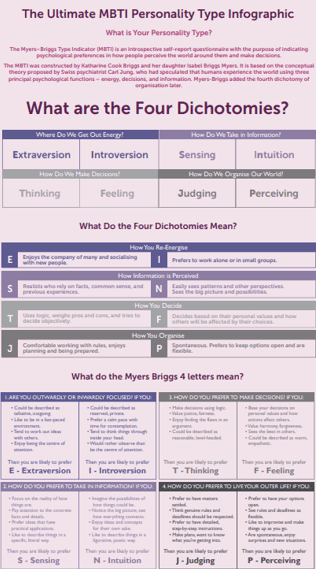
5) How Can I Guess People’s Personality Types?
The only way to be really sure of someone’s Type is to ask them to complete the Indicator. You can talk to us to arrange this. That said, when you are comfortable with your Type, it does get a lot easier to make educated guesses of the Type of those around you, helping you to get the best from them.
In the meantime, there are some simple observations about the 4 elements above that you can make that might help you. And once you know which part of each element someone seems to prefer, then you have a potential 4-letter type that has a dynamic personality to it, rather than a seemingly random set of 4 letters.
Try This Now
Pick someone whose Type intrigues you, for whatever reason, and work through the following prompts:
They might be an Extrovert if they:
- Seem to think ‘through their mouth’.
- Work out their ideas by talking them through.
- Answer a question with some of their thought process and ‘mental scribble’.
- Are sociable and expressive.
- Enjoy action and variety, becoming impatient with long, slow jobs.
- Act quickly, sometimes without thinking.
- Learn best through doing or discussing.
- Prefer to communicate by talking.
- Find it comfortable speaking at length to express their thoughts.
If you haven’t understood an Extrovert, then you haven’t looked or you haven’t listened!
They might be an Introvert if they:
- Seem to think things through without talking.
- Work out ideas by reflecting on them.
- Answer a question with the result of their thinking.
- Can be private and contained.
- Enjoy quiet for concentration, tending not to mind working on one project for a long time without interruption.
- Like to think before they act, sometimes without acting.
- Learn best by reflection, and mental ‘practice’.
- Prefer to communicate in writing.
- Are economical with the number of words used to express their thoughts.
If you haven’t understood an Introvert, then you haven’t asked them!
Are they closer to E or closer to I?
Let’s Look at Their Myers Briggs Preference for Information Next
They might have a Sensing preference if they:
- Use experience or standard ways to solve problems.
- Seldom make errors of fact.
- Build carefully and thoroughly towards conclusions.
- Describe events in a factual, concrete way, using a structured approach.
- Focus on what is real and actual.
- Understand ideas and theories by putting them into practice.
- Notice and remember details.
- Enjoys applying new learning – there is a practical purpose.
They might have an Intuitive preference if they:
- Like solving new and complex problems.
- Make errors of fact or omit detail.
- Move in bursts of energy, following hunches and sometimes going off at a tangent.
- Describe events by telling you the highlights, switching from one part of the story to another.
- Focus on patterns and meanings.
- Want to clarify ideas and theories before putting them into practice.
- Are most interested in the big picture.
- Enjoy learning a new skill without necessarily needing to use it.
Are they closer to S or closer to N?
Let’s look at how they make decisions next
They might have a Thinking preference if they:
- Solve problems with logic.
- Can be firm-minded, giving tough news when appropriate.
- Hurt feelings without intending to.
- Critiques new ideas as a way of evaluating them.
- Are fair – they want everyone treated equally.
- Strive for an objective standard of truth.
- Are reasonable.
They might have a Feeling preference if they:
- Are guided by both personal values and impact on people.
- Can be tender-hearted, disliking or even avoiding telling people unpleasant things.
- Enjoy pleasing people, even in small ways.
- Accept new ideas and evaluate them later.
- Are fair – they want everyone treated as an individual.
- Strive for harmony.
- Are compassionate and empathic.
Are they closer to T or closer to F?
Finally, let’s look at Living – how they like to live their life!
They might have a Judging preference if they:
- Work best when they can plan their work (and their life).
- Like finishing a task ahead of the deadline, even creating their own deadline before this to avoid last-minute stresses.
- Prefer finishing one task before moving to the next.
- Write lists to prompt action on specific tasks.
- Feel satisfied when they have made a decision, but may decide too quickly.
- Enjoy structure and schedules.
- ‘Work before play’.
They might have a Perceiving preference if they:
- Work best when they can be flexible and spontaneous at work (and in life).
- Tend to get a burst of energy towards the end of a project and finish bang on the deadline. Are energised by last-minute pressures.
- Prefer multi-tasking.
- Use lists as options and possibilities.
- Prefer to keep their options open as long as possible before deciding, but may decide too late.
- Adapt readily to changing situations and may actively make change happen.
- ‘I can play anytime’.
Are they closer to J or closer to P?
The four letters represent an individual’s preferences in the MBTI.
Once you have worked through each of these scales, you will have in front of you a 4-letter Type for the person you were trying to guess. The dynamics of the 4 letters give more information than the 4 individual letters alone. It’s the conversation about your 4 letters that will bring the greatest insights. That’s when the magic really happens.
Excuse the Interruption, but Here’s a Little Bit About Us…
We are the soft skills training provider to the UK Grocery Industry, helping Suppliers to win more business. They choose us because of our money-back guarantee, our relevant experience, and because we make their learning stick.

6) Do We Know the MBTI of Anyone Famous?
There are many opinions and guesses out there about the Personality Type Indicator of famous people – some more accurate than others. Take a look at some famous MBTI people.
7) Further Information, Personality Test, Reading and Resources
You can find further insight, detailed definitions and clarification of all the key Myers Briggs terms mentioned in this guide in our Glossary of Terms.
#1- Articles from Our Blog:
#2- Watch Personality Type Indicator Video Tips
Here are 1-minute videos on how you can understand and use MBTI better:
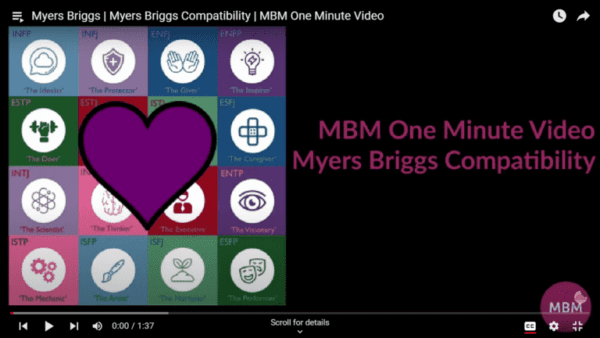
Also, take a look here at the TED talk by Professor Brian Little which looks at traits in psychology:

#3- Contact Us
Finally, contact us to discover your “Type.” Through discussion and feedback, you will understand how the dynamics of this 4 letter Type say so much more about you than the individual letters alone. So…does knowledge of yout Type lead to a richer life experience and even a happier life…? Yes, I think it does!
So feel free to get in touch to find out how our Myers Briggs training can help you. Simply visit here to contact us or email us at helpme@makingbusinessmatter.co.uk, and we will be happy to get back to you.


